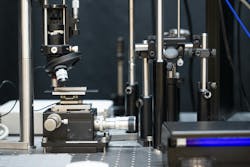A golden opportunity to boost x-ray imaging and scanning
Gold is a precious metal with many uses, and is used for electronics due to its good electrical conductivity and within medical implants because it’s inert.
Now, our research team has discovered a new use for gold: making x-ray images sharper and potentially speeding up the processing of x-ray scans. These findings point the way toward improved medical imaging and faster security clearance (see video).
Our team is from across the globe: the study was co-led by Nanyang Technological University in Singapore and Poland’s Lukasiewicz Research Network – PORT Polish Centre for Technology Development, in collaboration with the CNRS-International-NTU-Thales Research Alliance, a French-Singaporean joint research laboratory, the Institut Lumière Matière CNRS in the University of Lyon, and Nano Center Indonesia.
Visualizing x-rays
At the heart of our advance is how the electrons in gold behave, boosting devices that help visualize x-rays used in health and security scans.
X-rays are invisible, so a detector with scintillating materials is used to image them. Like glow-in-the-dark paint, these scintillators light up when absorbing x-rays. Sensors can capture this visible light to create images based on the x-rays, and the x-ray visuals become sharper and more detailed if the light is brighter.
Scintillating materials that can respond very quickly and emit more intense visible light in response to x-rays are used in digital photosensors for modern-day x-ray imaging.
One family of compounds that exhibit these properties is called perovskites, which are also known to convert sunlight into electricity in solar cells. If the intensity of the light emitted from perovskites as well as the materials’ response speed could be improved, we would be able to achieve state-of-the-art x-ray imaging. This includes being able to perform x-ray analysis in color, such as for photon-counting computed tomography used in medical imaging.
We demonstrated the possibility of pushing the capabilities of scintillators in this direction.
Using a perovskite called butylammonium lead bromide as the scintillating material in our experiments, we added a gold layer to it. We discovered that the visible light emitted by the materials became 120% brighter after adding the gold layer. Laboratory results showed that the light had an average intensity of around 88 photons per kiloelectronvolt.
The increased brightness resulted in x-ray images that were 38% sharper, and the ability to distinguish between different points in the visuals improved by 182%.
Our study also suggests that gold can potentially speed up the processing of x-ray scans. The amount of time scintillating materials with the gold layer took to stop giving off light after x-ray exposure was shortened by 1.3 ns on average, or nearly 38%. As a result, the materials are ready for the next wave of radiation faster.
Electrons in synchrony
These observations are due to gold being plasmonic. When the metal’s electrons are exposed to visible light, they move in synchronized wave-like patterns, similar to ripples forming in water after dropping a pebble. The visible light in this case comes from the scintillating materials after they react with x-rays.
When electrons moving in this way interact with the scintillators, the materials give off visible light more quickly, which makes the emitted light brighter.
In our experiments, the layer of gold we added to the perovskite samples was just 70 nm thick. The study of plasmonic phenomena at such nanoscale dimensions is known as nanoplasmonics.
Our inspiration for the study came from combining two areas of research that had not been explored previously for x-ray detectors.
Earlier, our team members had discovered that after a thin, nano-sized layer of gold was added to certain materials and exposed to visible light, the materials gave off brighter visible light than before. Meanwhile, other team members were studying how structures at the nanometer scale could enhance x-ray generation and detection.
The team put these two ideas together and decided to see if gold could have a similar effect on scintillating materials used in scanners to detect x-rays.
We now plan to explore whether nano-sized notches added to the surface of gold could further boost the light emitted by scintillators in response to x-rays.
Exciting prospects
Our study illustrates the potential of nanoplasmonics in optimizing ultrafast imaging systems that need high spatial resolution and high contrast, such as x-ray bioimaging and microscopy.
By melding our results with other technologies, state-of-the-art applications in radiation imaging are possible. This includes improving x-ray analysis in color or making time-of-flight x-ray medical imaging more accurate.
Airport security could benefit, too, since sharper and more detailed images from x-ray security scans allow items in baggage to be detected more easily. Luggage could also be screened more quickly.
Dennis Schaart, who researches novel technologies for medical imaging and radiation oncology and was not involved in the study, describes our latest findings as “opening a new avenue for the improvement of radiation imaging detectors based on scintillators.”
Schaart is the head of the medical physics and technology section in the radiation science and technology department at the Netherlands’ Delft University of Technology, and points out that the performance limits of commonly known scintillation mechanisms are close to being reached, but there is still a persistent demand for better solutions.
“The findings presented in this latest research point the way toward a new class of scintillation detectors in which the intensity and speed of light emission are enhanced through the manipulation of quantum-mechanical phenomena,” Schaart says.
“In principle, this work offers highly exciting prospects for scintillator developers to engineer optimal materials for a wide variety of applications,” says Schaart. “If the results presented in the research can be reproduced and scaled toward industrially produced scintillators, this will likely contribute to more accurate, more affordable, and more accessible medical diagnosis, as well as faster security scans.”
FURTHER READING
W. Ye et al., Adv. Mater., 36, 25, 2309410 (Jan. 2024); https://doi.org/10.1002/adma.202309410.
About the Author
Liang Jie Wong
Liang Jie Wong is a Nanyang assistant professor at Nanyang Technological University's School of Electrical & Electronic Engineering (Singapore).
Muhammad Danang Birowosuto
Muhammad Danang Birowosuto is a principal investigator at Lukasiewicz Research Network – PORT Polish Centre for Technology Development (Poland).


